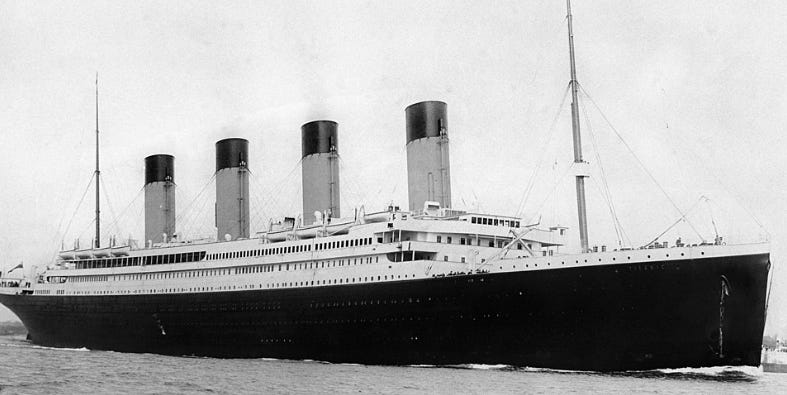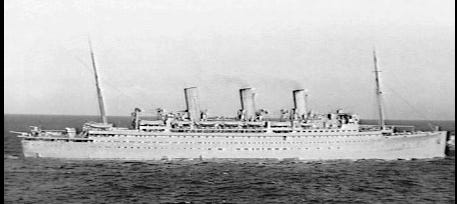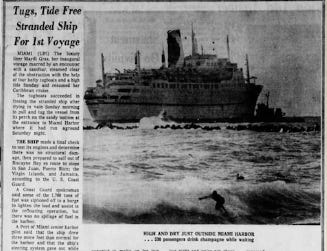He was nicknamed the “godfather of the modern day cruise industry,” which is now valued at $7.25 billion
Yet few people know the first ship he ever launched wound up stuck at sea
Since his father happened to be a division head at one of the largest cargo shipping companies in Israel, you could say that Ted Arison was “born” into the industry.
The company M.Dizengoff & Company was started in 1952 by the former first mayor of Tel-Aviv, Meir Dizengoff who was a very good friend of Ted’s father, Meir Arison.
The two had built the business into one of the most successful shipping companies in all of Israel.
Now if your father is the “head person” at a giant shipping company, odds are in your favor, you’ll be able to get a job there. And that’s what happened.
After Ted graduated from the American University of Beirut, his father gave him a job as an operations manager for the firm. And he stayed in that position until 1948, when Israel declared its independence, and that ignited the Arab-Israeli War.
Ted left the firm so that he could serve in the Israeli Army, fighting alongside his fellow countrymen.
But this wasn’t the first time Ted found himself involved in a war. Around the age of 15, his dad took him and his family on a vacation to Yugoslavia.
Unfortunately that’s right around the time World War II broke out. Ted’s father acted quickly to move his family to safety. He bought the last few remaining seats on a flight that was departing from Rome.
He then put the entire family into a cab where they endured a 600-mile ride to the airport. The family made their flight on time and arrived back home to Israel the next day.
After Ted finished his term of service with the Israeli military, rather than return to M. Dizengoff & Company, he started his own shipping agency. And it was doing quite well too until he bought one too many ships.
You see to expand his company; Ted went on a ship buying spree during the Korean War, which created a spike in the shipping industry. Ted was eager to capitalize on this new demand.
However, when the Korean War ended, the value of all those ships he bought dropped to almost nothing. In fact he went broke.
But we can’t count a good man out just yet. Ted recognized there was an opportunity to take his shipping model to the air. Well, not literally. You can’t fly ships in the sky. But you can buy airplanes and start an air freight transportation business.
And that’s exactly what Ted did. The company, Tran-Air was located in New York, so he moved the family to the U.S. He was so successful with this new venture that by 1959 he had reversed his misfortunes.
In 1966, at the age of 42, he retired from Tran-Air, sold the company, and moved his family once again, but this time to Miami, Florida.
A Cruising We Will Go
Before the pandemic hit, cruising was one of the fastest growing sectors of the travel and tourism industry.
In 2019, over 13.7 million passengers boarded a cruise ship that was departing from one of several U.S. ports located in states such as Florida, Georgia, California, and Alaska.
The most popular cruises are ones that run through the Caribbean and usually last about seven days. As for ships, well you can pick from 31 different ships. Some of the ships are so big, they can accommodate as many as 6,680 passengers.
Oh boy have cruise ships have come a long way since the Titanic was built. Compared to today’s cruise vessels, the Titanic was a mere miniature ship. It was 883 feet long, with only nine decks. Today’s ships average 1,184 feet in length and have as many as 19 decks.
Although Titanic technically was not a cruise ship but an ocean liner and was tasked with delivering over 6,000,000 pieces of mail and packages sent from the UK and other countries, it also carried passengers, as many as 2,240.
And the ship offered luxury accommodations similar to what you see in modern day cruisers from grand state rooms and swimming pools to lavish dining areas and a promenade deck.
Of course we all know what happened to the Titanic. It now sits roughly 12,500 feet under the waters near the coast of Newfoundland.
But what you might not know is that it was never fully promised to be “the world’s first unsinkable ship.”
Prior to its departure, a writer for a magazine article wrote that it was practically unsinkable. Promotional literature created by the ship’s manufacturer, the White Star Line, which also built the Titanic’s sister ship, the Olympic, reads “as far as it is possible to do so, these two wonderful vessels are designed to be unsinkable.”
While the Olympic never sank, it continued to carry passengers and mail until 1934 when it was “retired from duty.” On April 12, 1935, the Olympic was taken apart and sold as scrap. The last piece of the ship was sold in 1937.
From Here and There, And A Ship In Between
How in the heck did cruising become such a beloved form of travel?
Well, we can thank Albert Ballin for coming up with the idea of a cruise ship in the first place. In 1899, the Hamburg-American line based out of Germany, appointed him as their general director because they liked his vision of building ships meant solely for passengers.
And to make this happen as quickly as possible, Mr. Ballin started retrofitting used freight ships into cruise vessels. Not only did he retrofit the ships, but he also altered their routes.
You see in the winter months, freight ships remained mostly docked at ports because the seas were too cold and dangerous to traverse. But Mr. Ballin decided it would be more beneficial to send his retrofitted ships off to warmer climates such as in the Caribbean.
The first ship he retrofitted wasn’t exactly a luxurious cruiser. It was hard to hide some of the big machinery needed to run the ship. That meant less free space for passengers to move about.
The ships also had troubled navigating their way into small ports of call because back then most Caribbean islands didn’t have marinas properly built and equipped to house large vessels.
Mr. Ballin wasn’t going to let any of these things stop him from turning his vision into a hard core reality. He kept at it. Eventually he hired ship builders to build a cruiser from the bottom up.
In 1900, Mr. Ballin had the honor of christening the first cruise ship, Prinzessin Victoria Luise. Launching from Hamburg on June 29, the Victoria Luise explored ports in the West Indies and Venezuela.
What Mr. Ballin really did with his creation of the Victoria Luise is make cruising something people wanted to experience. You no longer had to be extremely wealthy and own a yacht to travel the open seas.
But as you might expect, all good things eventually come to an end. While on a cruise to the Caribbean, the Victoria Luise crashed against an uncharted ridge off the coast of Jamaica. The ship’s captain, Captain H. Brunswig had mistaken the light he saw in the harbor for the Port Royal Lighthouse.
But he was off course … like really off course. And although no passengers were hurt, Captain Brunswig’s pride was dealt a blow. He ended his life that same night.
As for the Victoria Luise, it sat stranded off the coast of Jamaica for several weeks until a tropical storm rolled in. Eyewitnesses watch in shock as waves began breaking over the ship’s bow relentlessly. Her fate was sealed. She sank to the bottom of the ocean.
Of her demise, Canadian-born writer John M. Brinnin wrote in his book, The Sway of the Grand Saloon: A Social History of the North Atlantic, “The sea had now claimed one of its prettiest prizes.”
Just four years after the Victoria Luise was claimed by the sea, the world of leisure cruising came to a sudden halt. It wasn’t just the sinking of the Victoria Luise that put it on hold, it was also the beginning of the Great Depression and then of course, the start of World War I.
It would take another person with a vision as large as the ocean to revive the industry. And that Dear Reader is exactly what Ted Arison accomplished and in a very big way.
Two Friends Walk Into A Cruise Ship
Since Ted had already started his own shipping agency while living in Israel, he figured why not do the same thing but this time while living in the U.S.
Well let’s say sort of the same thing … because Ted’s real goal was to start a cruise ship line. He had prior experience with cruise ships because in 1966, he worked as the general manager for the passenger shipping company Norwegian Caribbean Lines. It was the first company to package air fare and cruise vacations.
However to make his dream of owning a cruise ship a reality, Ted would need to buy a ship or build one.
Building one takes lots of money and time, so Ted decided the next best thing to do is buy a used one. But creating a cruise ship line is something he didn’t want to do alone.
So he asked his high school friend, Meshulam Riklis to work with him on this new business venture. Meshulam agreed especially when he found out that Ted already a ship in mind for the two to purchase … the RMS Empress of Canada.
The RMS Empress of Canada was launched to sea in 1960, mostly to help with the marked increase in migration of Europeans to Canada.
The ship was considered a real beauty for her time and measured 650 feet long. She had full air-conditioning with accommodations divided into 192 first class passengers and 856 tourist class.
All first class cabins and roughly 70% of tourist class had private facilities. The Empress also had an indoor pool, a cinema and a two-story high grand room known as the Canada Room.
The Empress made an impressive 121 round trips between Liverpool and Montreal. But as air travel became more popular in the 1960’s … because it offered speedier service, the desire to take a cruise declined.
The RMS Empress of Canada made her last transatlantic crossing from Montreal to London on November 23, 1971. And she sat at London’s Tilbury dock for several weeks patiently waiting to be rescued from the hands of scrap metal workers.
Ted and Meshulam bought the ship for get this … one dollar. For them it was a “steal of a deal” because the vessel had only been dry-docked for a few weeks, which meant she was still in relatively good shape.
Sure, her furnishings and decor were a bit outdated, but Ted and Meshulam didn’t see that as an issue. They did update a few pieces of furniture, but it was more or less “on the fly.” For instance, old wooden furniture was covered in tin to look more modern.
In truth, the only major updating done was on the ship’s restaurant. It went from “stuffy” looking to festive. In fact that became the core of their marketing messages … fun and festive. And it’s also why they named their new business, Carnival Cruise Lines.
Ted and Meshulam were ready to launch their new cruise ship, which they renamed the Madi Gras. They set the date for the first cruise on March 11, 1972.
Not Always Fair Winds and Following Seas
Sailors have a saying, “fair winds and following seas,” which implies that a vessel will have good winds and not have to pound the waves.
While the Madi Gras might have had fair winds, she did do some pounding … meaning she ran aground on a sandbar off Miami Beach.
To make matters worse, many of the 530 passengers were travel agents who took the cruise so they could experience first-hand the fun and festivity of Carnival Cruise Lines. And based on that experience, then could recommend Carnival to their travel clients.
The ship was re-floated the next day and made its way back to port. Needless to say the travel agents weren’t impressed. Ted and Meshulam lost millions of dollars as the Mardi Gras did nothing more than sail on a sea of red ink.
But the two weren’t going to give up. In fact over the next few years, they focused their marketing messaging on the different activities and entertainment that were available on board, rather than the ship’s destination.
And that strategy paid off. Passengers loved the idea of having fun on a cruise, something that other cruise lines ignored. They focused on the accommodations their ships offered, instead of putting the fun into cruising.
By 1975 Carnival Cruise Lines was finally making a profit. So Ted bought two more ships, and the company’s earnings increased substantially.
Over time Ted and Meshulam acquired other cruise lines, such as Holland America and Cunard. The two friends turned cruising into the latest travel craze.
In 1985 Carnival Cruise Lines was rated the top private company of the year by the South Florida Business Journal.
Just two years later in 1987, Ted and Meshulam sold shares of Carnival to the public but retained a large portion of the company's stock.
By 1988, Carnival had become the biggest cruise operation in the world. And Ted Arison found himself on the list of Forbes richest people, with at the time, a net worth of more than $1.5 billion.
Still Sailing Strong
Today Carnival owns 45 ships, which sail under the Holland America, Cunard, Seabourn, Costa Cruises and Windstar brands. Several more ships are on order.
As for sales, just last year Carnival generated revenues of $2.5 billion, almost double that of its nearest competitor, and its ships account for about 40 percent of cruise traffic.
Ted’s net worth soared to an estimated at $5.6 billion, making him one of the richest men in the world. Because of the success he achieved with Carnival Cruise Lines, he was often nicknamed the “godfather of cruising.”
In 1990 Ted resigned as president of Carnival in favor of his son, Micky. And then in 1994 Ted returned to Israel, setting up Arison Investments Ltd.
Ted didn’t live much longer after his return to Israel. He had been battling cancer for several years and died October 1, 1999.
He was 75 years old.
Ted managed to turn a single cruise ship into the largest cruising company in the world. And it all started with a vision … making cruising fun.
Editor’s Note: I’ve been meaning to write the next issue of Just One Good Idea for quite some time. However several weeks ago we had a tragedy happen in our family and my attention was on working through the grief. Everyday is a better day than the one before. And now I can spend my time sharing more good ideas with you.
Awesome Quotes by Awesome People
“Dreams don’t come true unless you take action. The surest way to make your dreams come true is to live them.”— Roy T. Bennett







Thanks for sharing, I've missed your newsletter. Sorry to hear of your misfortune,I hope you and your family meet with tenderness and kindness as you begin to heal through the grief.